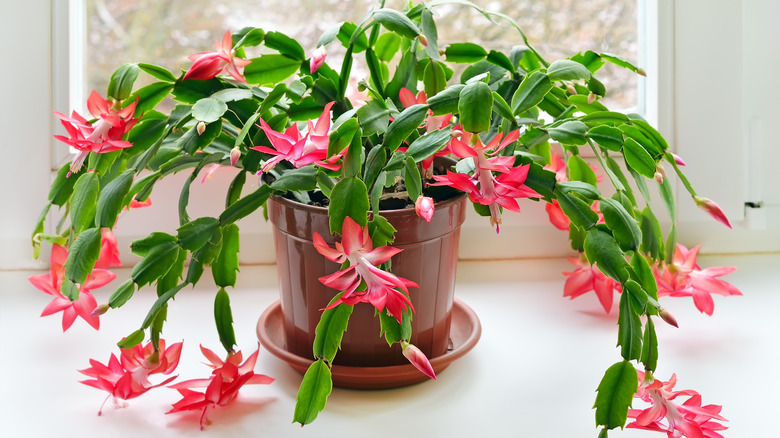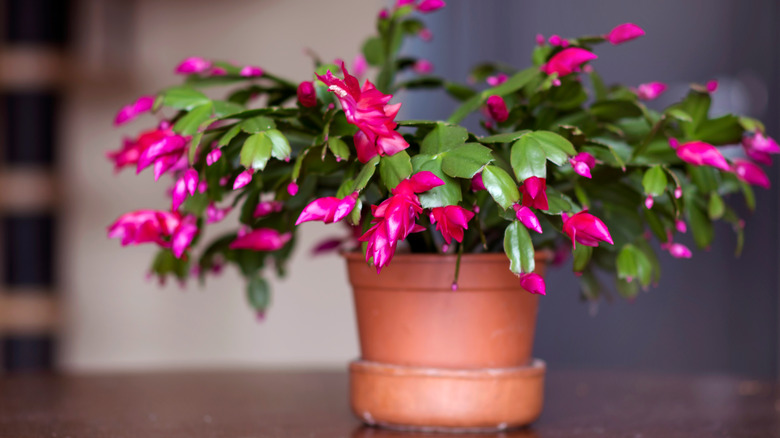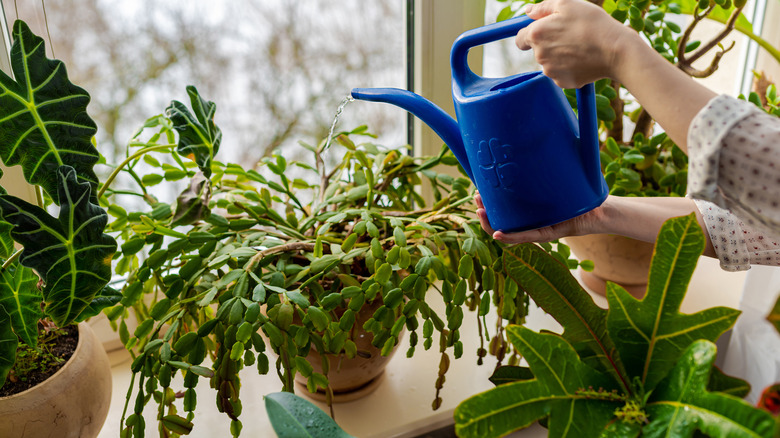The Best Way To Repot Your Christmas Cactus
The Christmas cactus is a unique plant that goes against everything plant owners believe about cacti. While "cactus" is in the name, they can't live in the desert. Instead, they are native to tropical rainforests and prefer humidity and moist soil. They are also different from most plants because rather than being dormant in the winter, they bloom tiny pink flowers, which gives them their name. In terms of care, you must provide them with proper humidity by misting them daily or placing a humidifier in the room. They also need water about every two to three weeks or when the top two layers of soil are dry. Bright light is also necessary, but too much direct sun will burn your plant.
To encourage your Christmas cactus to bloom, Chicago Botanic Garden recommends controlling the temperature your plant is exposed to and reducing the amount of sunlight it gets. The ideal night temperature for producing blooms is 50 to 55 degrees Fahrenheit. It will only need 13 hours of darkness daily when you provide a cool environment. If the temperature is over 70 degrees Fahrenheit, you must keep it in the dark for 15 hours. You should also increase how frequently you water it. Once your Christmas cactus blooms, you must wait for them to drop before repotting it.
Choosing the pot and soil
What you use to repot your Christmas cactus is just as important as how you do it. There are two components you need, the first being a new planter. It should be 1 to 2 inches larger than your plant's current pot. If the diameter were any bigger, there would be too much dirt holding onto water that its roots can't absorb, leading to root rot. The material of the pot also matters. Garden Lovers Club recommends a terracotta or unglazed ceramic planter. The clay will allow air to flow around the roots and help dry the soil.
The type of potting mix you use is just as crucial to your Christmas cactus' health. They prefer moist soil, but it shouldn't be soaking wet. Using well-draining soil like a commercial cactus potting mix will allow the necessary amount of water to be absorbed while the rest flows out the drainage hole. New Mexico State University recommends adding a large amount of nutrient-dense soil. You can do this by incorporating compost or peat. If you would rather create your own potting mix, include coarse sand or perlite for aeration with nutritious soil.
Repotting your Christmas cactus
To prevent transplant shock, you should repot your Christmas cactus during a specific time of year. You want your plant to be actively growing so it can recover from the trauma its roots undergo when you put them in new soil. According to Urban Organic Yield, the perfect time to do this is from late January to February. These few weeks are when your Christmas cactus should have just finished blooming. However, some end up growing flowers until March. If that's the case, wait until the last flower has died before repotting it.
Once you have your soil and new pot, you can gently pull your plant out of the old one. Then massage the ball of roots to loosen and remove some of the old soil. Sometimes the old potting mix can get compacted over time. If this is the case, place the root ball under running water to make it easier. Then take your new planter and fill it a third of the way with soil. Place your Christmas cactus in the middle and add the potting mix around the sides until it can stand up. There should be at least half an inch of space between the soil's surface and the lip of your pot. Finally, give it a moderate amount of water and place it in a shady area. Doing this will help prevent transplant shock. After a few days, you can return to regular care.


